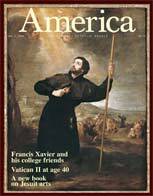Members of the Society of Jesus are often accused of excessive pride in their order and its history. This can be a fair critique. Sometimes, for example, Jesuits speak as if St. Ignatius Loyola were the first Christian to discover prayer. Not long ago at a retreat house, I gave a talk about Ignatian spirituality, which prompted a Benedictine in the audience to say, with good nature, "You know, St. Benedict used to pray from time to time too! "But there are some things of which the Jesuits and their colleagues can be justly proud, and for which they can be abundantly grateful to God. Their record in the arts is among them.
A newly published book, Jesuits and the Arts: 1540-1773, is the first comprehensive survey of the worldwide artistic enterprise of the early Society of Jesus. By any measure, this new volume is brilliantly conceived, consistently fascinating and absolutely gorgeous to look at. Beginning with a chapter entitled Saint Ignatius and the Cultural Mission of the Society of Jesus, written by John W. O’Malley, S.J., the study takes the reader on a journey through the history of Jesuit architecture in Europe (including an entire chapter on the Church of the Gesù in Rome); the influence of the Society on Italian Renaissance and Baroque painting; the surprising story of Jesuit theater; the artistic, and especially architectural, heritage of the Jesuits in Latin America (including the legacy of the Reductions in South America, made well known by the movie The Mission); and the Jesuit-influenced artistic achievements in North America and Asia. Jesuits and the Arts represents the first time that these disparate threads have been pulled together in a single volume.
This impressive work of scholarship, boasting contributions from an array of experts from Italy, Spain, Germany, France, Argentina and the United States, has been edited by Father O’Malley, professor of church history at Weston Jesuit School of Theology, in Cambridge, Mass., and Gauvin Alexander Bailey, professor of art history at Clark University in Worcester, Mass. (An earlier version of the book appeared in 2003 in Italian, French and Spanish, edited by Giovanni Sale, S.J.)
The book’s scholarship is more than matched by the full-color images that crowd every page. Quite simply, this is one of the most beautiful books I have ever seen. It continues the new tradition of richly made books from St. Joseph’s University Press, which published another lovely book in 2002 entitled Stained Glass in Catholic Philadelphia, whose prosaic title belies the book’s depth of scholarship and the beauty of its pages.
Jesuits and the Arts arrives at a propitious time. Starting this month, the Society of Jesus will begin celebrating what it is calling a jubilee year, marking three important Jesuit anniversaries. Five hundred years ago St. Francis Xavier, the great missionary, was born. So was Blessed Peter Faber, a Jesuit somewhat less well known among the general public, but who was said by Ignatius to be the best giver of the Spiritual Exercises in his time. The Society of Jesus and its colleagues will also mark in 2006 the 450th anniversary of the death of St. Ignatius.
So perhaps the Jesuits and their co-workers can, at least for the next year or so, be forgiven for showing some pride and being just a little more grateful to God. To share in our celebration we offer over these next few pages a sampling of images from Jesuits and the Arts.
In the print version of America, this article is accompanied by photos from Jesuits and the Arts: 1540-1773.








